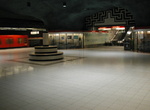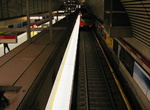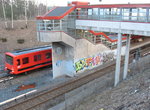Helsinki, Finland
Overview
As the capital of Finland, and by far the country's largest city, tranquil Helsinki is, in the normal Scanidnavian manner, blessed with a very efficient public transport network. Whilst the tram network is vastly more extensive than the one-route Metro, the street-based network carries only slightly more passengers than the Y-shaped Metro line, which predominently serves the eastern side of the city. A reasonably-sized commuter rail system also serves the northern and western areas.
Trams
The tramway network in Helsinki offers good coverage of the city. The first tram operated in 1891 - albeit horse-drawn - and by 1901 the whole network was electrified. The bulk of the fleet consists of indigenously built Valmet twin-section articulted cars, some of which have been modified with the addition of a low-floor central section. A handful of 50-year old Valmet non-articulated cars remain, although apparently their operation is sporadic and limited to peak hours, at best. Despite their advancing years, the articulated cars are generally in good condition and ride well.
Modern stock consists of 40 examples of the Bombardier Variotram multi-section articulated type. First delivered in 1998, the type's introduction was a protracted affair and the final car didn't arrive until nearly five years later. As is worryingly common with modern low-floor designs, the Variotrams were fraught with difficulties, and in a parallel of the Siemens Combino debacle each has, or will, return to the factory in Germany for rectification. After Helsinki public transport operator HKS had apparently threatened to return the whole batch to Bombardier, an arrangement was reached that should 85% of the Variotrams not be available for service, the purchase could be cancelled and the batch of 40 returned en masse. Seemingly related to this, a Croatian-built Crotram articulated car of the Zagreb fleet was trialled on the Helsinki network during early 2008. HKS has stated it will require 40 new lor-floor trams over the coming years and Crotram would appear keen to bid, despite the company having yet to deliver a car to a city other than Croatian capital Zagreb,
Concurrent with the Variotram difficulties, a handful of classically-styled Duewag GT6 articulated sets were acquired secondhand from the Mannheim fleet in Germany. Apparently a short-term measure, they are all operated in various advertising livery and perhaps unfortunately none of the operational fleet carries the pleasant Helsinki green and cream colours. A similar ex-Ludwigshafen eight-axle Duewag car forms part of the charter fleet and this does carry the traditional livery, however. More recently, a further handful of secondhand Duwags have arrived from Mannheim, this time fitted with centre lor-floor sections.
Whilst several routes radiate northward from the waterfront and central area, the Helsinki network is unusual in having two circular services. Line 3 operates in a figure of eight manner, with route 3T operating in the clockwise from the top direction and 3B anticlockwise. These pass through much of the CBD and are marketed to tourists, with pamphlets to this effect produced in several languages extolling the various places of interest passed by the routes. A slightly more 'outer circular' route is line 7, which parallels line 3 for a fair distance before diverging to serve more outlying areas. Clockwise service is line 7A and anti-clockwise 7B. Also of note is line 4, which heads east out of the CBD to serve the busy ferry terminal area, terminal of plentiful passenger ferries to Estonia and Sweden. Although much of the network is on conventional street track, a proportion - particularly in the central area, and along the busy Mannheimerstrasse - is on central reservation.
A number of older Helsinki trams form a 'charter fleet', whilst several are either stored or statically exhibited at the city's Tram Museum. Unusual amongst the charter fleet is a 1959 Valment bogie car, which has been repainted red and fitted out as a mobile bar! It makes several circular trips of the central area during the afternoon and early evening in summer, each lasting around 40 minutes.
In summary, Helsinki is a pleasant city which has a reasonable amount to offer light rail enthusiasts. For more than a few days though, it might be best combined with a trip to the Russian city of St Petersburg, which is served by three trains a day and is a journey time of about five hours away. The Russian city's metro is certainly worth a visit!
Metro
The Metro consists of 17 stations, seven of which (in the central area) are below ground. Rolling stock is a mixture of modern Bombardier equipment and mid-life Finnish-built stock, introduced from the line's commencement in 1977. Gauge is the same as that of VR - Finnish national railways - at 1524mm, the same as used on Russian metros; indeed, some peak-hour local commuter trains are hauled by Russian-built electric locomotives. A number of Metro extension projects are apparently at the planning stage, possibly including one to the airport at Vantaa - currently only accessible to the car-less traveller by taxi or Finnair bus. That said, an extension to the commuter network to serve Vantaa would seem to be the preferred option at present.
Photo Gallery
Trams
| Five Random Images | ||||
 Image 85787 (135k, 704x528) Photo by: Tim Deakin Location: Kaisaniemi |  Image 85797 (141k, 704x528) Photo by: Tim Deakin Location: Mannerheimintie |  Image 85808 (102k, 704x528) Photo by: Tim Deakin |  Image 85810 (106k, 704x528) Photo by: Tim Deakin Location: Hakaneimi |  Image 85814 (120k, 704x528) Photo by: Tim Deakin Location: Ullanlina |
Metro
| Five Random Images | ||||
 Image 48970 (139k, 1044x788) Photo by: Simo Melenius Location: Ruoholahti (Gräsviken) |  Image 48989 (199k, 1044x788) Photo by: Simo Melenius Location: Kaisaniemi (Kajsaniemi) |  Image 48998 (165k, 1044x788) Photo by: Simo Melenius Location: Hakaniemi (Hagnäs) |  Image 102369 (268k, 1044x788) Photo by: Simo Melenius Location: Myllypuro (Kvarnbäcken) |  Image 102398 (213k, 1044x788) Photo by: Simo Melenius Location: Rastila (Rastböle) |
Page Credits
By Tim Deakin.